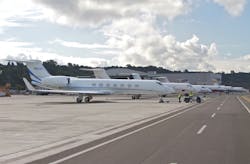At almost every airport across the country, an FBO’s leasehold is comprised of a mixture of buildable and non-buildable areas, dependent on a number of factors. One factor defining non-buildable areas may be found in an airport’s minimum standards, where a leasehold improvement formula is sometimes located. For example, for each square foot of improvements on a leasehold--such as hangars or an FBO building--a certain corresponding percentage of non-buildable square footage is in turn dedicated to aircraft parking or transition areas, known more simply as “ramp” space. More often than not however, the real factor which affects FBOs and dictates those non-buildable areas of a leasehold is FAR Part 77, Imaginary Surfaces.
Under Part 77, several imaginary surface areas of an airport are defined, and their dimensions are a function of the type of airport itself and the approaches available to that airport, among other factors. The first surface, and perhaps most obvious is referred to as the primary surface. At ground level and emanating from the centerline of the runway, the primary surface is the area which must be object free-- excepting those required for the safe movement of aircraft, such as lighting, taxiway signage and navaids. While other imaginary surfaces, such as the approach surface on runway ends are more commonly known to pilots, it is another imaginary surface--the “transitional surface” that most affects FBOs. Transitional surfaces establish a 7:1 slope of a protected area outwards from either side of the runway, or primary surface. As a great many FBO leaseholds are located parallel to a runway, improvements such as hangars or an FBO itself must be lower than the transitional surface. Hence, to build a hangar with a 28-foot door for example, this may mean that building is set back some 200 feet. It is therefore the transitional surface that creates non-buildable areas of leaseholds and for FBOs, effectively dictates the size and layout of their ramp.
Whether a function of a leasehold formula for non-buildable areas or Part 77, the seemingly ubiquitous asphalt known as the ramp can create unusual angst between an FBO, its customers, and sometimes, the airport itself. Why?
With very rare exceptions, FBOs at public use airports in the United States pay monthly leasehold fees to their landlord; be it the city, county, municipality or operator of the airport itself. That leasehold fee is usually straight-forward: the total amount of square footage for a given parcel, multiplied by a formula price per square foot. Taxes and other fees often accompany the monthly rent, so to speak. Returning to the primer on buildable versus non-buildable areas of a leasehold, a significant portion of an FBO’s leasehold may be unbuildable. Thus, those unbuildable portions become ramp space, and are only able to be used for parking of aircraft, and providing FBO line services, such as fuel. If that ramp area is asphalt or similar, an FBO must maintain that surface at great expense. Over the lifetime of a leasehold, an FBO may need to resurface or replace the ramp several times. Minor surface repairs such as crack sealing may take place annually, while seal coatings occur perhaps every three to five years depending on the airport’s geography. For an FBO then, a great portion of their monthly rent to their airport is for an area of the leasehold they cannot build upon but must maintain it at great expense.
Recovering Costs
So how can they recover those costs? Handling fees, parking fees, or ideally, both.
And that, as they say, is the rub. For some customers of an FBO, no pricing mechanism yet invented seems as unsavory as paying to park on the FBO’s ramp for a few minutes. “But we’re just dropping off our passengers” is the well-intentioned yet all too familiar refrain from the flight crew.
Likewise, a daily or overnight parking fee charged by an FBO seems like highway robbery, or does it? Here’s an experiment: Fly into an airport near a major city with a Gulfstream G450, and park at the FBO. Next, rent a four-door car, and drive downtown for the day. Park the car in a well maintained, fenced parking lot, complete with a security camera system and a parking attendant. What was the cost to park the rental car for the day?
For the purpose of this example, let’s say the rental car was a Toyota Camry, and the parking fee was $15 for the day. Dimensionally, the Toyota accounts for 96 square feet, which means a mere $0.15 was applied on a per square foot basis. Now, charge the 7,020-square-foot Gulfstream the same per square footage price for the day. The net result? A $1,053 daily parking fee for the airplane! Yet, it is exactly the same formula applied to a parking lot. Highway robbery? Hardly. FBOs are wise to consider the real cost of parking aircraft, and should charge accordingly.
Finally, the unbuildable areas of a leasehold can be the source of occasional tension between an airport and an FBO. Customarily, airports increase leasehold rates on set schedules; every three to five years for example. For an FBO, this stings all the more when a significant portion of their leasehold is unbuildable. With a trickle of a revenue stream to offset cost, FBOs are left little recourse but to lobby for height limitation discounts, aviation-use discounts or otherwise from their airport for their non-buildable areas. Airports themselves, though handling large volumes of money from a budgetary perspective, are likewise run on a shoestring--as excess fees are channeled back into infrastructure or other airport improvement programs.
Somewhere in the pricing chain the weakest link must give. It’s academic that airports should charge leasehold fees, and FBOs should charge parking fees. It would seem logical that end-users--aircraft operators--should expect to pay handling fees, parking fees or both. And yet, that notion is the source of a very real debate. It is no small irony that debate takes place below an FAA defined imaginary surface.





